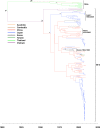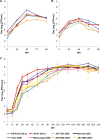Dynamics of the emergence and establishment of a newly dominant genotype of Japanese encephalitis virus throughout Asia
- PMID: 24501419
- PMCID: PMC3993778
- DOI: 10.1128/JVI.02686-13
Dynamics of the emergence and establishment of a newly dominant genotype of Japanese encephalitis virus throughout Asia
Abstract
In recent years, genotype I (GI) of Japanese encephalitis virus (JEV) has displaced genotype III (GIII) as the dominant virus genotype throughout Asia. In this study, the largest collection of GIII and GI envelope gene-derived viral sequences assembled to date was used to reconstruct the spatiotemporal chronology of genotype displacement throughout Asia and to determine the evolutionary and epidemiological dynamics underlying this significant event. GI consists of two clades, GI-a and GI-b, with the latter being associated with displacement of GIII as the dominant JEV genotype throughout Asia in the 1990s. Phylogeographic analysis indicated that GI-a diverged in Thailand or Cambodia and has remained confined to tropical Asia, whereas GI-b diverged in Vietnam and then dispersed northwards to China, where it was subsequently dispersed to Japan, Korea, and Taiwan. Molecular adaptation was detected by more than one method at one site (residue 15), and coevolution was detected at two pairs of sites (residues 89 to 360 and 129 to 141) within the GI E gene protein alignment. Viral multiplication and temperature sensitivity analyses in avian and mosquito cells revealed that the GI-b isolate JE-91 had significantly higher infectivity titers in mosquito cells from 24 to 48 h postinfection than did the GI-a and GIII isolates. If the JE-91 isolate is indeed representative of GI-b, an increased multiplicative ability of GI-b viruses compared to that of GIII viruses early in mosquito infection may have resulted in a shortened extrinsic incubation period that led to an increased number of GI enzootic transmission cycles and the subsequent displacement of GIII.
Importance: Japanese encephalitis virus (JEV), a mosquito-borne flavivirus, represents the most significant etiology of childhood viral neurological infection in Asia. Despite the existence of effective vaccines, JEV is responsible for an estimated 68,000 human cases and a reported 10,000 to 15,000 deaths annually. Phylogenetic studies divided JEV into five geographically and epidemiologically distinct genotypes (GI to GV). GIII has been the source of numerous JEV epidemics throughout history and was the most frequently isolated genotype throughout most of Asia from 1935 until the 1990s. In recent years, GI has displaced GIII as the most frequently isolated virus genotype. To date, the mechanism of this genotype replacement has remained unknown. In this study, we have identified genetic determinants underlying the genotype displacement as it unfolded across Asia. JEV provides a paradigm for other flaviviruses, including West Nile, yellow fever, and dengue viruses, and the critical role of the selective advantages in the mosquito vector.
Figures





Similar articles
-
Genetic diversity of Japanese encephalitis virus isolates obtained from the Indonesian archipelago between 1974 and 1987.Vector Borne Zoonotic Dis. 2013 Jul;13(7):479-88. doi: 10.1089/vbz.2011.0870. Epub 2013 Apr 16. Vector Borne Zoonotic Dis. 2013. PMID: 23590316 Free PMC article.
-
Molecular epidemiology of Japanese encephalitis in northern Vietnam, 1964-2011: genotype replacement.Virol J. 2015 Apr 1;12:51. doi: 10.1186/s12985-015-0278-4. Virol J. 2015. PMID: 25889499 Free PMC article.
-
Genotype patterns and evolutionary rates: uncovering Japanese encephalitis virus spread across Asia's climate regions.Acta Trop. 2025 Jul;267:107676. doi: 10.1016/j.actatropica.2025.107676. Epub 2025 May 25. Acta Trop. 2025. PMID: 40425079
-
Potential Role of Birds in Japanese Encephalitis Virus Zoonotic Transmission and Genotype Shift.Viruses. 2021 Feb 24;13(3):357. doi: 10.3390/v13030357. Viruses. 2021. PMID: 33668224 Free PMC article. Review.
-
Japanese encephalitis virus in India: An update on virus genotypes.Indian J Med Res. 2022 Oct-Nov;156(4&5):588-597. doi: 10.4103/ijmr.IJMR_2606_19. Indian J Med Res. 2022. PMID: 36926775 Free PMC article. Review.
Cited by
-
Sero-Molecular Epidemiology of Japanese Encephalitis in Zhejiang, an Eastern Province of China.PLoS Negl Trop Dis. 2016 Aug 25;10(8):e0004936. doi: 10.1371/journal.pntd.0004936. eCollection 2016 Aug. PLoS Negl Trop Dis. 2016. PMID: 27560360 Free PMC article.
-
Japanese Encephalitis Virus and Schizophyllum commune Co-Infection in a Harbor Seal in Japan.Vet Sci. 2024 May 13;11(5):215. doi: 10.3390/vetsci11050215. Vet Sci. 2024. PMID: 38787188 Free PMC article.
-
Antivirals and Vaccines.Int J Mol Sci. 2023 Jun 19;24(12):10315. doi: 10.3390/ijms241210315. Int J Mol Sci. 2023. PMID: 37373462 Free PMC article.
-
Japanese encephalitis virus genotype III from mosquitoes in Tarlac, Philippines.IJID Reg. 2022 May 16;4:59-65. doi: 10.1016/j.ijregi.2022.05.005. eCollection 2022 Sep. IJID Reg. 2022. PMID: 36093364 Free PMC article.
-
The feasibility of field collected pig oronasal secretions as specimens for the virologic surveillance of Japanese encephalitis virus.PLoS Negl Trop Dis. 2021 Dec 3;15(12):e0009977. doi: 10.1371/journal.pntd.0009977. eCollection 2021 Dec. PLoS Negl Trop Dis. 2021. PMID: 34860839 Free PMC article.
References
-
- Innis BL. 1995. Japanese encephalitis, p 147–174 In Porterfield JS. (ed), Exotic viral infections. Chapman & Hall, London, United Kingdom
-
- Igarashi A, Tanaka M, Morita K, Takasu T, Ahmed A, Akram DS, Waqar MA. 1994. Detection of West Nile and Japanese encephalitis viral genome sequences in cerebrospinal fluid from acute encephalitis cases in Karachi, Pakistan. Microbiol. Immunol. 38:827–830. 10.1111/j.1348-0421.1994.tb01866.x - DOI - PubMed
Publication types
MeSH terms
Grants and funding
LinkOut - more resources
Full Text Sources
Other Literature Sources

